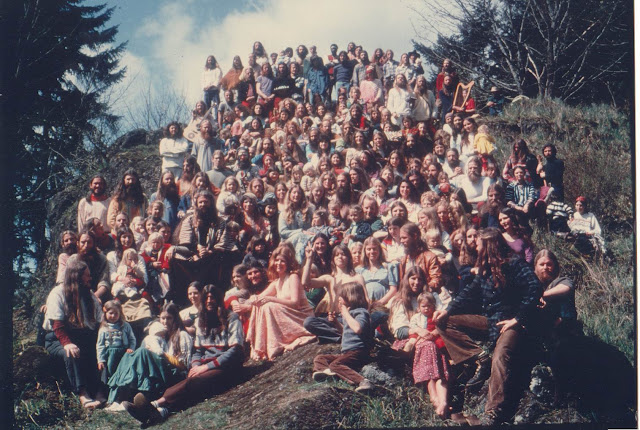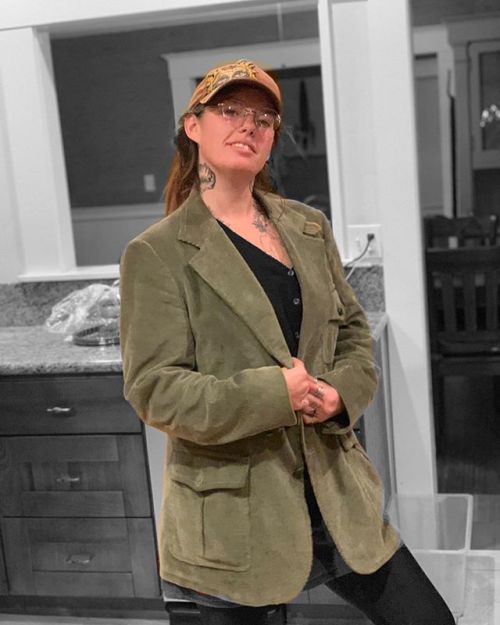 |
| Love Family Passover, 1977 |
In the Summer of 1976 the annual Rainbow Gathering was held in Montana by Cave Mountain, near Choteau, in Lewis and Clark National Forest. At the Gathering, the Love Family invited everybody who had stayed for the cleanup to come to their ranch near Arlington, Washington. I was traveling and living in a school bus at the time and since we were going to another healing gathering near Chelan later that month we decided to visit the Love Family and check out their ranch.
The Love Family ranch was a beautiful rustic pastoral commune of a few dozen hard working folks who welcomed us without reservation. The property was an old ranch snuggled into the western foothills of the Cascade Range. The family members were restoring it as best they could, tearing down the electrified fencing and putting up barbwire, caring for the horses and cows, milking by hand every morning, and raising a variety of fruits and vegetables. They also made their own cider and wine. Every week or so we would take some of the harvest into Seattle where the Love Family ran a free tea house and kitchen, feeding and caring for the homeless and others in need.
It was pretty awesome. I really loved getting up before dawn, milking the cows, mending the fences, gardening & harvesting, and delivering food to the Seattle kitchen. The Love Family also had 9 beautiful spacious Victorian homes on Queen Anne Hill, the highest named hill in Seattle. I would stay in one of these after delivering food and beverages and often worked on restoration/repair projects like adding shake shingles and such. When they learned I had studied mathematics at university I became the math teacher for the home schooled children of the Love Family. Sometimes while in Seattle we would go down to one of the piers where the Love Family fishing boat would be unloading its catch and we would filet fish for later sale or distribution via the free soup kitchen. It was always work, work, work, but work with a spiritual purpose and carried out with a lot of love and fun.
We also went on long camping trips through the orchards and vineyards of the Yakima Valley. Some of us would visit the ranchers and farmers, asking if we could glean their fields after the harvest. Almost all of the farmers we met with in the Yakima Valley were religious Christians who, after learning of the Love Family faith and practice of giving away food to the needy, would gladly let us come into their fields & setup camp to glean the remaining fruits & vegetables. Again, really great.
I have fond memories of those gleaning trips. We would live in tents in the fields & setup a makeshift kitchen & communal campfire. Doing chores was a joy - we would all sing songs together, some playing guitars or drums while the rest of us sang and washed dishes or whatever needed to be done. Also, we were always high :)
I didn't really get into the religious aspects very much but I did come to learn that the Love Family sacraments included smoking a lot of pot and the occasional group LSD celebration. There was a family band that rocked the house while we all tripped. Ok, maybe there were cult aspects, but hey what a great cult! Also, I don't even know what a cult is - I was just enjoying the communal spiritual and intentional living aspects. It was pretty amazing that these hippies had pulled together houses in Queen Anne Hill, a ranch in the Cascades, a fishing fleet, and a rumored property in Alaska (I never visited that so cannot confirm). All this while running a free tea house, feeding the needy, and welcoming all who wished to join.
There were aspects I did not agree with. There were some Old Testament hangovers - the family was definitely a patriarchal society with women relegated to a more subservient role. But that was true of other elements of hippiedom in the 70s as well. But mostly this was New Testament Christianity with Love as the central and highest aspect. They (and most Christian churches in America) could have used a little more Christian tolerance - when some members were arrested by the cops and gave their real world identification to the cops they were kicked out. Huh? Well, even Heaven may not be perfect.
There were aspects I did not agree with. There were some Old Testament hangovers - the family was definitely a patriarchal society with women relegated to a more subservient role. But that was true of other elements of hippiedom in the 70s as well. But mostly this was New Testament Christianity with Love as the central and highest aspect. They (and most Christian churches in America) could have used a little more Christian tolerance - when some members were arrested by the cops and gave their real world identification to the cops they were kicked out. Huh? Well, even Heaven may not be perfect.
The 70s were, in my view, most notable for the advent of the intentional commune - young hippies gathering together on land they somehow managed to acquire or gain access to, and setting up self-sustaining communal back-to-the-land operations. Most were short-lived - mainly because access to land would be withdrawn by the property owner, often after some incident, or due to economic collapse, often after some takeover by an aggressive bullshit "leader". The Love Family sustained for decades, although it apparently ran on hard times after I left with the property owner demanding his assets be returned. I don't know that story, all I know is the heyday when there was plenty and plenty to love.
I hope any remaining members are well and continuing to love, sing, get high, dance, and help others as they did when I was there. Thanks Love Family!
Here is what Wikipedia has to say about the Love Family:
The Love Family, or the Church of Jesus Christ at Armageddon, was a U.S. communal religious movement led by Paul Erdman, who renamed himself Love Israel. The Love Family began in 1968 as one small communal household on Queen Anne Hill, Seattle, and within the first ten years, it expanded to a network of communal homes and businesses. As more people arrived and settled in the surrounding neighborhood, Erdman, as the leader, continued to inherit land and homes (primarily from those who joined) in other, more rural areas of Washington State, Alaska, and Hawaii. Most of the property is no longer under the control of Erdman, having been sold or returned to the original owners via litigation.
Sources differ on the Love Family's duration; some claim that after a fractious conflict in 1984, the community was reduced to a small fraction residing in suburban Bothell, Washington, while according to The Seattle Times and an article written by Serious Israel, the Love Family continued living on their 300-acre (1.2 km2) property in Arlington, Washington. The Love Family flourished on that acreage from 1984 until 2004, when, according to the Seattle Times, some families moved to other, smaller properties. The Arlington commune supported both a local organic restaurant and an annual festival open to the public called the Garlic Festival, which drew healthy crowds to the property.
Spiritual foundations
"Love Israel" is a play on one of the fundamental affirmations of the group;, "Love is real". Equally important to the remaining members are three other commonly used affirmations: "We are one", "Love is the answer", and "Now is the time". These statements reflect three of the most widely experienced phrases of the 1960s and were the foundation stones of the earlier Love Family culture, even after the bulk of the group had moved on. These three 'fundamental belief' statements were often used to stave deeper curiosity and invoke a deeper discussion into the role of humanity on this earth. Remaining family members still maintain that they were called together to help each other cultivate love, oneness and the presence of God in everyday family life. Very little is spoken about the continuing belief that Love Israel is a leader directed through his vision from God. They also believe that their gathering has Biblical roots and that their purpose is to help fulfill directed prophecies to benefit man and the promises of Jesus.
The current members still claim to view themselves as both the spiritual tribe of Israel and the Church of Jesus Christ at Armageddon, where Armageddon means the time and place of the gathering of God's family. A few family members continue to be renamed (and newborns named) to remind all that each person's character is gifted with a predominant attribute such as Charity, Honor, Honesty or Contentment, that may already be who they are or part of where they need to be.
History
The pioneers of the family came together gathered by vision and aggressive recruiting in Seattle's hippie community. Erdman was a salesman with a vision; charismatic and well spoken. Members came to hold him as better than themselves over time, working hard to make sure there was as seamless a hierarchy as possible. The small remaining core of Erdman's community continues to this day.
In 1984, it was reported that membership dwindled from 500 to 40 as the group was forced to give back assets and money to disenchanted members. Notably, the Love Family returned to former member Daniel Gruener aka Richness Love $1.6 million and 14 Seattle properties.
Current status
The Love Family evolved from being a highly concentrated communal society with a shared economy, to what some non-members call a cult with their own laws and ways. The greater community in time became a social network of autonomous households that interact through a shared culture that they have continued to create together, without the robes and peer-enforced order. Presently, those that continue to claim membership in what remains of the Family are concentrated in homes and lots on the shore of the Columbia River (Lake Roosevelt), just below Canada.
In 2007, the former Arlington family grounds became Camp Kalsman, a Jewish summer camp.
In January 2016, it was reported founding member Love Israel was battling stage 4 cancer, and on February 1 reportedly passed.
In film
A film It Takes A Cult, about the Love Israel Family, director Eric Johannsen who grew up as part of it, was shown at the 2009 Seattle International Film Festival.
Wikipedia text is available under the Creative Commons Attribution-ShareAlike License; additional terms may apply.
Wikipedia text is available under the Creative Commons Attribution-ShareAlike License; additional terms may apply.



